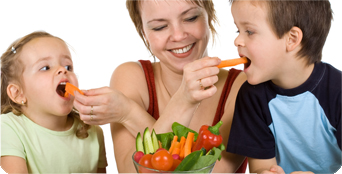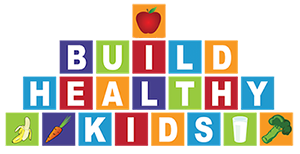| |

The
Basics Made Simple
 Daily
Nutrition Guide Daily
Nutrition Guide
Getting
Started, An Assessment
Perfect
Serving Sizes
Choosing
Healthy Food
Tips
for Good Eating
|
|
Daily
Nutrition Guide

It is very important that your
child gets the proper amount of calories and nutrients
in order for him/her to function at an optimum level. The
amount of calories and servings of food that your child needs
every day is based on several factors; age, gender and activity
level.
The more active your child is, the more calories he or she
needs. Males generally need more than females and usually
older children need more calories than younger children.
If your child is sick or has a medical condition, the calorie
requirement can change so it is always best to seek professional
advice in these situations either from a certified nutritionist
or a medical doctor.
 Click
here to find out the daily nutrition requirements
for your child. Click
here to find out the daily nutrition requirements
for your child.
Research has found that children are not getting enough essential
nutrients so these are important to keep in mind when planning
your child’s diet.
• Children and adolescents
do not get enough calcium, potassium, fiber, magnesium,
and vitamin D & E. Sources of these nutrients are listed
below:
• Fiber- whole grains, fruits and vegetables
• Vitamin E – nuts, seeds, wheat germ oil and
vegetable oils
• Calcium- low fat and fat free dairy products, rhubarb,
spinach, collard greens, and sardines
• Magnesium- whole grains, nuts, pumpkin seeds, and
white, black, navy beans
• Potassium- legumes, potatoes, dried apricots, beet
greens, prune juice and dairy products
• Vitamin D- sunshine, fortified dairy and juice,
cod liver oil, salmon, tuna and mackerel
• Teenage girls and boys especially do not get enough
calcium in their diet.
• Most children do not get the required amount of
fruits and vegetables.

Essentials
of Fruits and Vegetables
Promoting fruit and vegetables consumption
is essential for good health both now and in the future. As
a nutritionist for 20 years and a mom of two, if I could wave
a magic wand and make one change in the way most kids eat,
it would be to make sure they get a minimum of 5 servings
of fruits and vegetables every day.
An easy way to remember this is to serve a fruit and vegetable
at each meal and one at snack time. Click
here to see how you can offer fruits and vegetables
over a typical day.
Fruit and vegetable consumption has been shown to prevent
certain forms of cancer and heart disease. They provide many
nutrients and the necessary fiber that children need. Having
your child fill up on produce will keep them from snacking
on high- calorie, but empty nutrient varieties of junk food.
It is hard to binge on fruits and vegetables as the fiber
has a satiating effect; kids will stop when they feel full.
With junk food, the salt and sugar present cause an addictive
eating response whereby the child continues to eat and eat,
never feeling satisfied.
The majority of children does not get enough vegetables in
their diet and most certainly do not get the variety they
need. The number one vegetable consumed is white potatoes
and many times these are prepared in a unhealthy way, which
takes away the benefits.
The top fruits consumed by
kids are apples and bananas. Children need to eat a rainbow
of colors in order to get the complete advantage of the many
vitamins, minerals and phytonutrients that are present in
different amounts.
Try offering berries and tropical fruit as a change and green
leafy (sauté in olive oil with soy sauce for a yummy
alternative or chop up finely in soups) and orange vegetables
(next time you make mashed potatoes use 1⁄2 white potatoes
and 1⁄2 yams or sweet potatoes).
Click
here for help in choosing the best fruits and vegetables.

Most babies enjoy eating pureed vegetables
and fruit. Continue to encourage your child’s enjoyment
by offering many varieties through the various stages of growing
up. If your child complains that they no longer like a particular
vegetable tell them that “it likes you” and continue
to offer it.
Also try planting a garden. Gardening teaches children where
food comes from and it helps to get them excited about produce
to the point where they will be more likely to eat it. Even
those living in apartments can plant tomatoes and herbs on
their terraces or at a nearby local neighborhood garden plot.
Check out areas by you.
Essentials
of Calcium
Calcium is an essential
nutrient that is used to build strong bones and teeth so it
is especially important that your child gets enough calcium
in their diet during the crucial growing years. By the time
children reach young adulthood, their bones have formed.
If your child’s intake before the age of twenty was
inadequate, they run the risk of forming softer and more brittle
bones which puts them at risk for fractures and osteoporosis
later in life, especially for girls.
It is important for your child to understand that they can
not make up for an inadequate intake later in life, after
their mid 20’s all they can do to promote “bone
health” is to prevent calcium from being lost from their
bones as they age.
Children in the United States get the majority of their calcium
needs from dairy products, but if your child does not like,
or can not tolerate dairy, don’t worry as there are
numerous other calcium sources.
Fortified fruit juices, soy milk, leafy greens, white beans,
almonds, canned salmon, and sardines with bones are just some
examples of these.
In the past 30 years soda consumption has risen while milk
consumption has dropped and this has left our children vulnerable
to developing weak bones. In fact 87% of girls and 64% of
boys between the ages of 9 and 13 do not get enough calcium
in their diet. Encourage children to drink a glass of low
fat milk with every meal or some other calcium source that
provides 200-300mg of calcium.
The table below lists the amount of calcium that a child needs
every day. Also make sure that children get 400 IU’s
of vitamin D daily because this vitamin is needed to absorb
the calcium in their diet.
| Recommendations for Daily
Calcium Intakes |
| Age |
Girls and Boys |
Glasses of Milk
(8oz)/
Servings of Dairy |
| Birth to 6 months |
210 mg |
Formula/breast milk, no dairy until
12 months |
| 7-12 months |
270 mg |
Formula/breast milk, no dairy until
12 months |
| 1-3 years |
500 mg |
2 (whole milk 1-2yr) |
| 4-8 years |
800 mg |
3 low or non-fat |
| 9-18 years |
1300 mg |
4 low or non-fat |

Essentials
of Vitamin D
When sunlight hits our
skin, it turns the cholesterol within the skin into vitamin
D. Since the beginning of time, people did not need to be
aware of this essential vitamin or if they received enough
of it, as long as they spent time outdoors.
These days there are numerous warnings provided by many sources
about risks for skin cancer with unprotected sun exposure.
As parents we are left needing to decide what is worse; increasing
our child’s risk for skin cancer by letting them get
sun exposure without sunscreen (you can’t make vitamin
D if there is sunscreen blocking the sun), or running the
risk of our child becoming vitamin D deficient.
While many parents are aware of the risk of skin cancer from
too much skin exposure to the sun, relatively few parents
are aware of the need for adequate vitamin D levels.
There is a need to be concerned about vitamin D, because the
majority of children have insufficient blood levels. Children
who have deficient vitamin D levels have higher blood pressure
and blood sugar levels and lower levels of the good cholesterol
they need. This can then lead to heart disease and diabetes
if it occurs over a long period of time.
The reason that the majority of children are not getting enough
vitamin D is probably due to a decline in the amount of milk
children drink and the increased use of sunscreen. In light
of recent research findings regarding the safety of vitamin
D supplementation and the widespread prevalence of vitamin
D deficiency, the American Academy of Pediatrics has determined
that it is safe for children to take supplements of vitamin
D.
They doubled their guidelines recently, recommending that
all children, starting soon after birth, take a supplement
of 400IU’s of vitamin D unless they are drinking 32oz
of formula or milk fortified with vitamin D.
The reason it is difficult to prescribe “sun”
instead of “supplements” is due to the uncertainty
surrounding the dose of vitamin D that your child can make
when they are exposed to the sun.
All of the following factors affect the ability of skin to
make vitamin D;
• amount and frequency of sunscreen usage;
• the intensity of the sunlight available, which depends
on the time of the year and where you live; and
• being dark skinned because those individuals with
a darker complexion do not make vitamin D as efficiently as
those with light skin.
Talk with your child’s pediatrician and determine what
is best for your child; sun exposure, supplementation or a
combination of both. You may live in an environment where
your child can obtain enough vitamin D year round, while for
others some sun exposure during the summer and spring months
(but not during peak time of 10AM – 2PM when the risk
of a sunburn is great) is adequate.

Since vitamin D is essential for growing
strong bones and keeping your child’s immune system
strong, it is important to make sure your child obtains the
400 IU’s a day that they require.
 |
Dr.
Deb's Bottom Line
|
 |
An Average Day (1600 calories) Click
here to determine
how many calories your child needs a day and make adjustments
if it is over or under 1600 calories.
| Example A |
Example B |
Breakfast
1⁄2 cup fruit
1⁄2 cup milk
1 oz whole grain
*Cereal with milk and berries
*1/2 cup Yogurt topped with granola and fruit |
Breakfast
1⁄2 cup fruit
2 oz whole grain
1 oz meat/bean
*Scrambled egg with 1⁄2 bagel, 1⁄2 cup juice
*2 pancakes or waffles with 1 turkey sausage and 1⁄2
small apple |
Morning Snack
1⁄2 cup fruit
1⁄2 cup milk
*1/2 small Apple with 1 slice hard cheese
*1 cup Cottage cheese and grapes |
Morning Snack
None: In school or camp |
Lunch
1⁄2 cup vegetables
1⁄2 cup fruit
1 cup milk
1 oz grains
2 oz meat/bean
*1/2 turkey and cheese sandwich with carrot sticks, milk
and fruit cup
* 1 cup lentil soup with crackers, celery sticks, milk
and grapes |
Lunch
1⁄2 cup vegetables
1⁄2 cup fruit
1 cup milk
2 oz grains
1 oz meat/bean
*1 cup pasta with meat and tomato sauce, 1 cup milk and
a peach
* 1 sandwich with 1 oz ham, green pepper sticks with ranch
dressing, milk and applesauce |
Afternoon Snack
1⁄2 cup vegetables
1 oz grain
*Baked tortilla chips with salsa and cucumber slices
*Crackers and cherry tomatoes |
Afternoon Snack
1⁄2 cup vegetables
1 cup milk
1 oz meat/bean
*1 1⁄2 oz cheddar cheese, 1⁄2 oz nuts and
veggie sticks
*Veggie sticks with 2 TBL hummus dip and 1 cup milk |
Dinner
1 cup vegetables
1 cup milk
2 oz grains
3 oz meat/beans
*3 oz baked chicken with 1 cup pasta and cheese sauce,
steamed carrots and 1cup milk
*2 Turkey or beef Taco’s with 2 oz meat and 1 oz
shredded cheese,1/2 cup tomatoes, 1 cup salad greens and
1 cup milk |
Dinner
1⁄2 cup fruit
1 cup vegetables
1 cup milk
1 oz grains
2 oz meat/bean
*2 oz Salmon with 1⁄2 cup rice, 1⁄2 cup broccoli
and 1⁄2 cup green salad with 1 cup milk
*1 slice cheese pizza, 1⁄2 cup milk, 1 cup salad
with 1⁄2 cup chick peas and 1⁄2 cup cherry
tomatoes |
|
|
 |
Tips
|
 |
|
|

